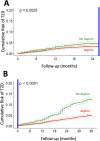Aspirin reduces the risk of type 2 diabetes associated with COVID-19
- PMID: 40604299
- PMCID: PMC12177057
- DOI: 10.1038/s44324-025-00072-3
Aspirin reduces the risk of type 2 diabetes associated with COVID-19
Abstract
This study aimed to determine whether daily low-dose aspirin reduces the risk of type 2 diabetes (T2D) associated with COVID-19. A longitudinal cohort of 200,000 adults followed from 2018 to 2022 was analyzed, comparing T2D incidence between aspirin users and non-users. Propensity score matching was used to balance the groups. The incidence of T2D was substantially lower in the aspirin group, with Cox regression showing a 52% risk reduction. Kaplan-Meier analysis confirmed a significant divergence in cumulative T2D risk after two years. This protective effect was observed both before and during the COVID-19 pandemic, with a stronger association during the pandemic period. These findings indicate that daily low-dose aspirin significantly reduces the risk of COVID-19-associated new-onset T2D, highlighting the role of inflammation in the pathogenesis of T2D triggered or unmasked by COVID-19.
© 2025. The Author(s).
Conflict of interest statement
Competing interests: The authors declare no competing interests.
Figures


Similar articles
-
The development of type 2 diabetes management in people with severe mental illness in the Capital Region of Denmark from 2001 to 2015.Acta Psychiatr Scand. 2024 Mar;149(3):219-233. doi: 10.1111/acps.13650. Epub 2024 Jan 6. Acta Psychiatr Scand. 2024. PMID: 38183340
-
Intravenous magnesium sulphate and sotalol for prevention of atrial fibrillation after coronary artery bypass surgery: a systematic review and economic evaluation.Health Technol Assess. 2008 Jun;12(28):iii-iv, ix-95. doi: 10.3310/hta12280. Health Technol Assess. 2008. PMID: 18547499
-
Dietary protein and risk of type 2 diabetes: findings from a registry-based cohort study and a meta-analysis of prospective cohort studies.Nutr Diabetes. 2025 Jun 3;15(1):25. doi: 10.1038/s41387-025-00380-z. Nutr Diabetes. 2025. PMID: 40461516 Free PMC article.
-
Antibody tests for identification of current and past infection with SARS-CoV-2.Cochrane Database Syst Rev. 2022 Nov 17;11(11):CD013652. doi: 10.1002/14651858.CD013652.pub2. Cochrane Database Syst Rev. 2022. PMID: 36394900 Free PMC article.
-
Comparison of two aspirin doses for the prophylaxis of pre-eclampsia in twin pregnancy: a multicenter retrospective study with propensity score matching.Am J Obstet Gynecol. 2025 Jul;233(1):55.e1-55.e10. doi: 10.1016/j.ajog.2024.12.030. Epub 2025 Jan 7. Am J Obstet Gynecol. 2025. PMID: 39788361
References
-
- Stiegmann, R. A., Payne, C. B., Kiel, M. A. & Stahlman, S. L. Increased prevalence of overweight and obesity and incidence of prediabetes and type 2 diabetes during the COVID-19 Pandemic, Active Component Service Members, U.S. Armed Forces, 2018 to 2021. MSMR30, 11–18 (2023). - PubMed
-
- Cefalu, W. T. COVID-19 and rising incidence of diabetes: despite evolving data, an enigma still to be solved. Diab. Care46, 913–915 (2023). - PubMed
Grants and funding
LinkOut - more resources
Full Text Sources
